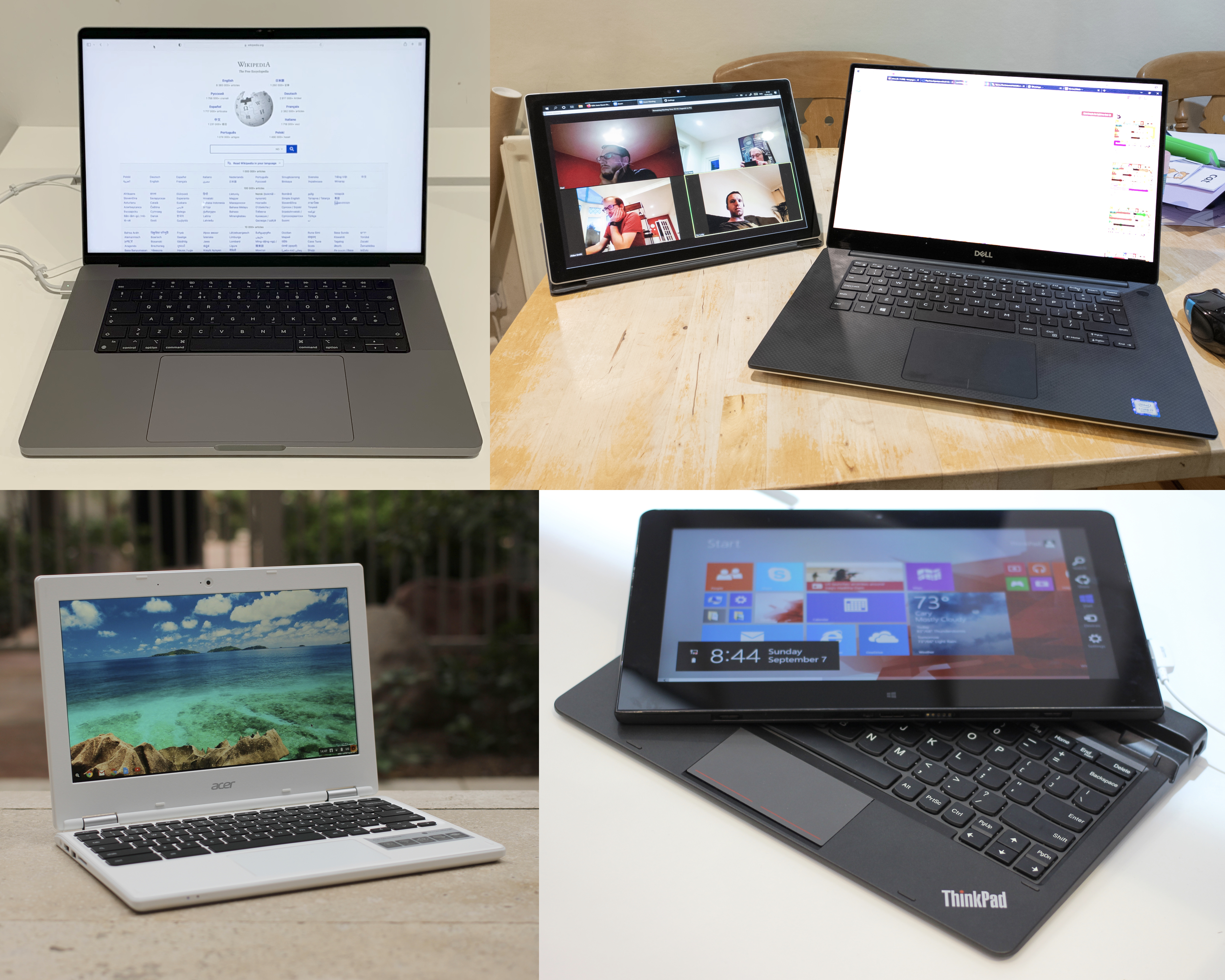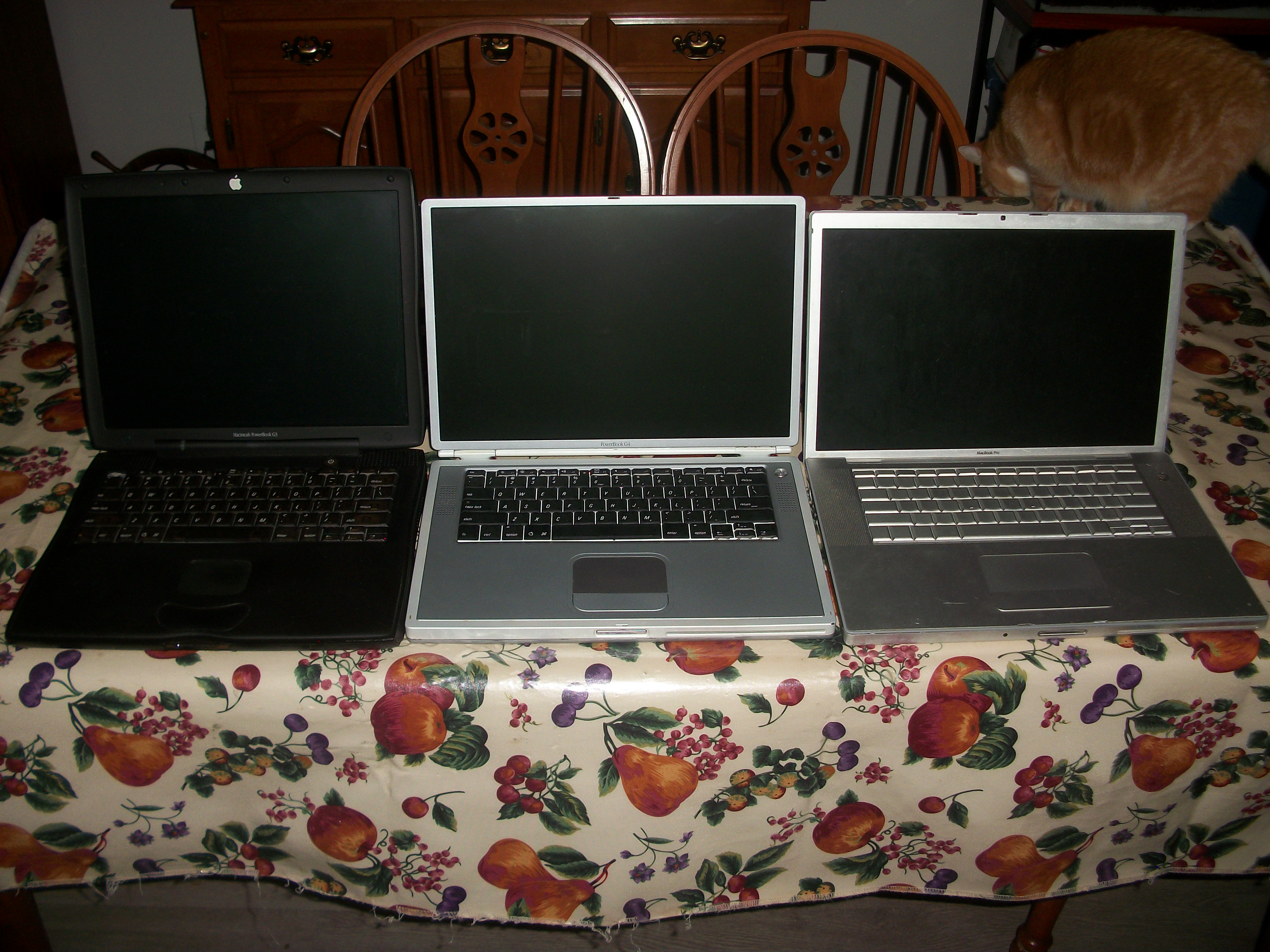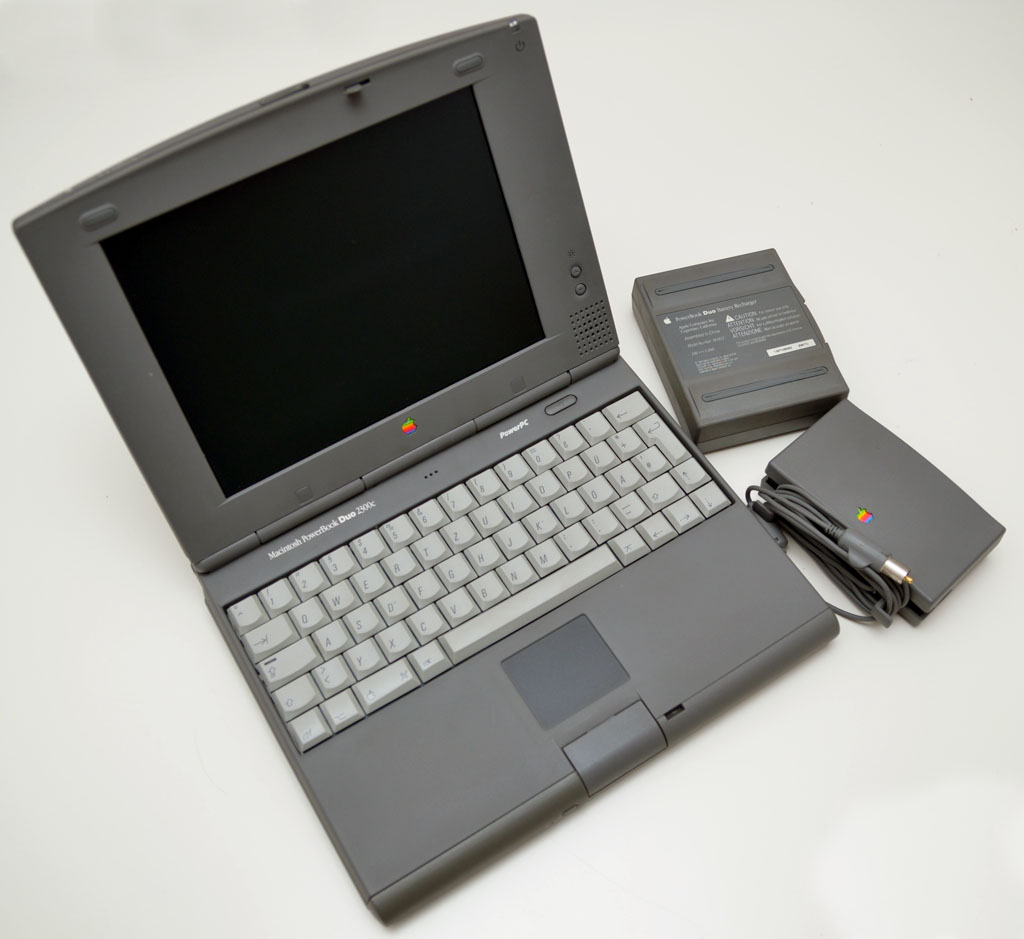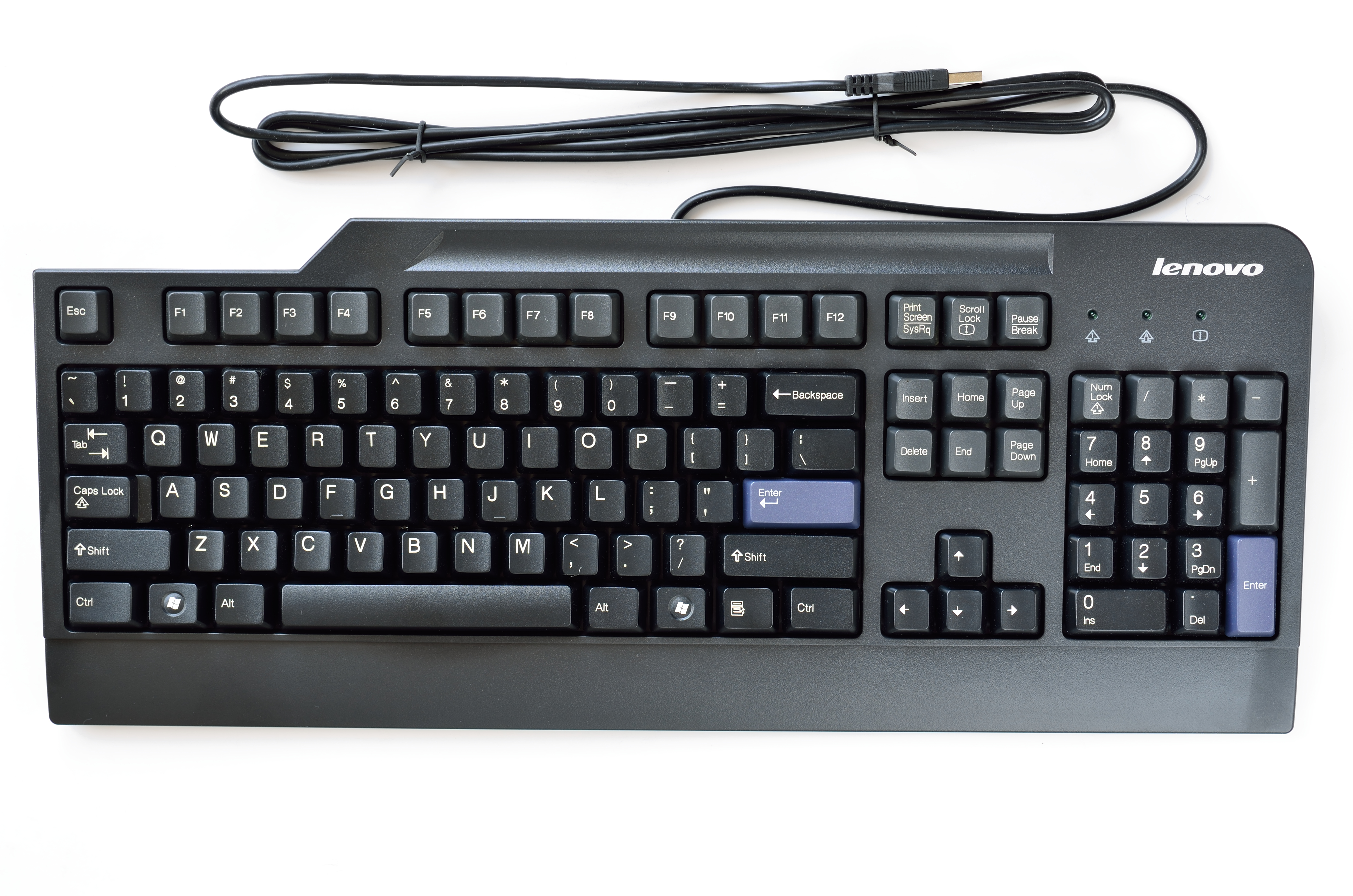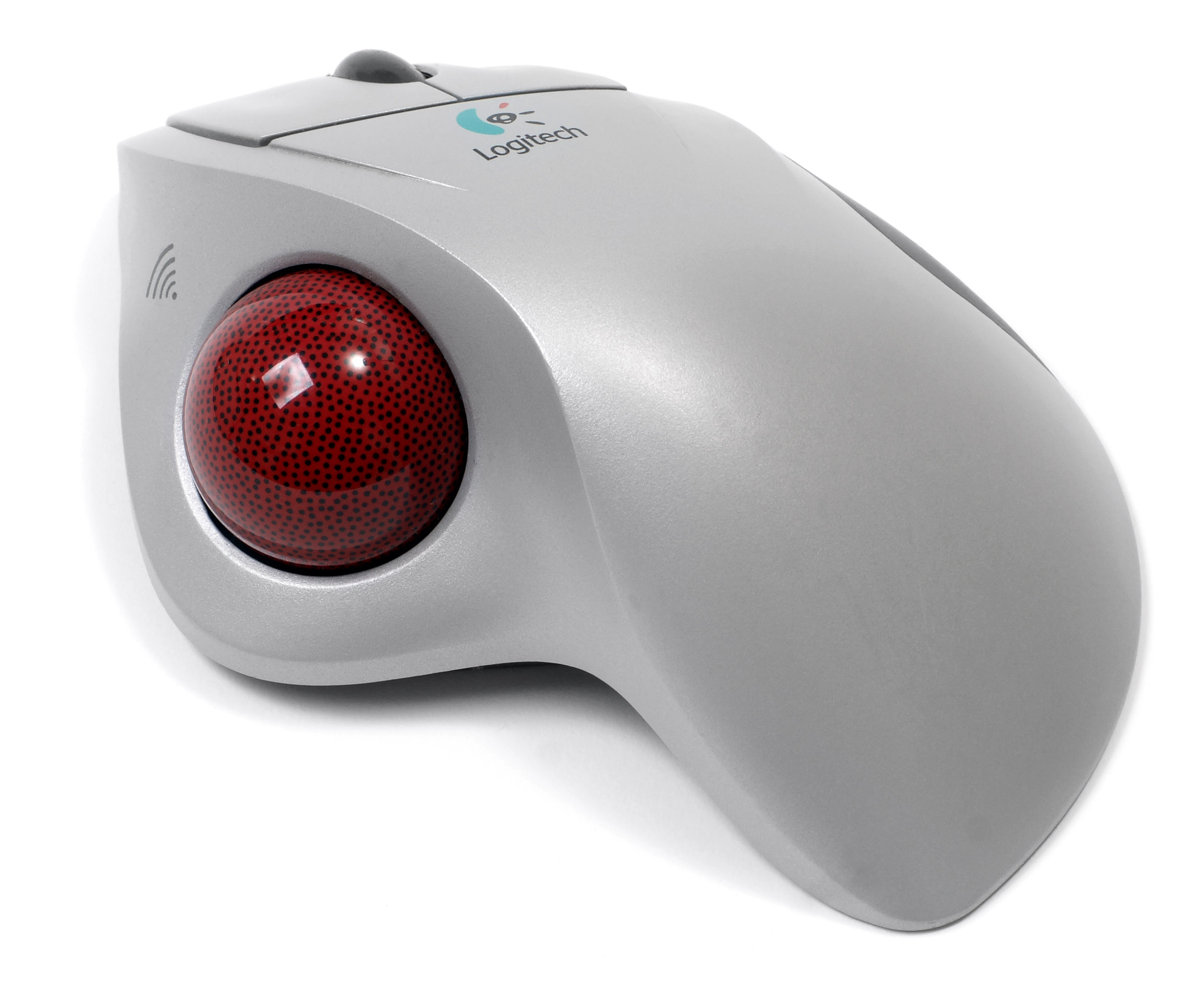|
PowerBook 180c
The PowerBook 180 is a portable computer released by Apple Computer along with the PowerBook 160 in October 1992. At the time, it constituted the new top-of-the-range model, replacing the previous PowerBook 170. Its case design and features are the same as that of the 170, but it shipped with the more powerful 33 MHz Motorola 68030 CPU and Motorola 68882 FPU. Along with the 160, it introduced a new power-saving feature which allowed the processor to run at a slower 16 MHz rate, the same speed as the original 140. PowerBook 180 The PowerBook 180 came with a (diagonal) active matrix LCD screen capable of displaying 4-bit grayscale at a resolution of 640×400, and a trackball was mounted beneath the keyboard. A 1.44 MB floppy disk drive and 80 MB 2.5-inch hard drive were also standard. The Apple Powerbook also gave an option of possible expansion to a 120 MB hard drive. They are equipped with keyboard stands to slant the keyboard. Like the Macintosh P ... [...More Info...] [...Related Items...] OR: [Wikipedia] [Google] [Baidu] |
Laptop Computer
A laptop computer or notebook computer, also known as a laptop or notebook, is a small, portable personal computer (PC). Laptops typically have a Clamshell design, clamshell form factor (design), form factor with a flat-panel computer screen, screen on the inside of the upper lid and an alphanumeric keyboard and pointing device on the inside of the lower lid. Most of the computer's internal hardware is in the lower part, under the keyboard, although many modern laptops have a built-in webcam at the top of the screen, and some even feature a touchscreen display. In most cases, unlike tablet computers which run on mobile operating systems, laptops tend to run on desktop operating systems, which were originally developed for desktop computers. Laptops are used in a variety of settings, such as at work (especially on business trips), in education, for PC game, playing games, Content creation, content creating, web browser, web browsing, for personal multimedia, and for general P ... [...More Info...] [...Related Items...] OR: [Wikipedia] [Google] [Baidu] |
Grayscale
In digital photography, computer-generated imagery, and colorimetry, a greyscale (more common in Commonwealth English) or grayscale (more common in American English) image is one in which the value of each pixel is a single sample (signal), sample representing only an ''amount'' of light; that is, it carries only luminous intensity, intensity information. Grayscale images, are black-and-white or gray monochrome, and composed exclusively of shades of gray. The contrast (vision), contrast ranges from black at the weakest intensity to white at the strongest. Grayscale images are distinct from one-bit bi-tonal black-and-white images, which, in the context of computer imaging, are images with only two colors: black and white (also called ''bilevel'' or ''binary images''). Grayscale images have many shades of gray in between. Grayscale images can be the result of measuring the intensity of light at each pixel according to a particular weighted combination of frequencies (or wavelen ... [...More Info...] [...Related Items...] OR: [Wikipedia] [Google] [Baidu] |
PowerBook
The PowerBook (known as Macintosh PowerBook before 1997) is a family of Macintosh-type laptop computers designed, manufactured and sold by Apple Computer from 1991 to 2006. It was targeted at the professional market; in 1999, the line was supplemented by the home and education-focused iBook family. During its lifetime, the PowerBook went through several major revisions and redesigns, often being the first to incorporate features that would later become standard in competing laptops. The PowerBook was replaced by the MacBook Pro in 2006 as part of the Mac transition to Intel processors. 680x0-based models PowerBook 100 series In October 1991, Apple released the first three PowerBooks: the low-end PowerBook 100, the more powerful PowerBook 140, and the high end PowerBook 170, the only one with an active matrix display. These machines caused a stir in the industry with their compact dark grey cases, built-in trackball, and the innovative positioning of the keyboard tha ... [...More Info...] [...Related Items...] OR: [Wikipedia] [Google] [Baidu] |
PowerBook Duo
The PowerBook Duo is a line of subnotebooks manufactured and sold by Apple Computer from 1992 until 1997 as a more compact companion to the PowerBook line. Improving upon the PowerBook 100's portability (its immediate predecessor and Apple's third-smallest laptop), the Duo came in seven different models. They were the Duo 210, 230, 250, 270c, 280, 280c, and 2300c, with the 210 and 230 being the earliest, and the 2300c being the final version before the entire line was dropped in early 1997. Weighing and slightly smaller than a sheet of paper at , and only thick, it was the lightest and smallest of all of Apple's PowerBooks at the time, and remains one of Apple's smallest notebooks ever produced. The Duo had the most in common with the original MacBook Air which only included one USB 2.0 port, one video port (requiring an adapter) and one speaker port, but no ability for expansion. The PowerBook Duo line was replaced by the PowerBook 2400, which was slightly larger in size ... [...More Info...] [...Related Items...] OR: [Wikipedia] [Google] [Baidu] |
Macintosh LC III+
The Macintosh LC III is a personal computer designed, manufactured, and sold by Apple Computer from February 1993 to February 1994. It replaced the commercially successful Macintosh LC II in Apple's lineup of mid-class computers, and was significantly faster, with MacWorld Magazine benchmarks showing 2x performance in all major categories - CPU, disk, video and maths. It was also significantly less expensive; the LC III with an 80 MB hard disk was priced at US$1,349 at introduction, $700 less than the LC II. The LC III was sold primarily (but not exclusively) to educational institutions, and a corresponding Performa variant called the Performa 450 was sold to the consumer market. A speed-bumped version, called the Macintosh LC III+ was released in October of the same year, with a 33 MHz CPU. Three Performa variants of this model were released: the 460, 466 and 467. These faster models replaced the LC III and Performa 450, with sales of the original models continuing unti ... [...More Info...] [...Related Items...] OR: [Wikipedia] [Google] [Baidu] |
Macintosh Portable
The Macintosh Portable is a portable computer that was designed, manufactured, and sold by Apple Computer, Inc. from September 1989 to October 1991. It is the first battery-powered Macintosh, which garnered significant excitement from critics, but sales to customers were quite low. It featured a fast, sharp, and expensive monochrome active-matrix LCD screen in a hinged design that covered the keyboard when the machine was not in use. The Portable was one of the early consumer laptops to employ an active-matrix panel—only the most expensive of the initial PowerBook line, the PowerBook 170, had such a panel. The machine was designed to deliver high performance, at the cost of increased price and weight. The Portable was discontinued in October 1991. The Macintosh Portable can run Macintosh System 6.0.4 through System 7.5.5. Background By the late 1980s, Macintosh users yearned for a portable version of their computer. Don Crabb titled his February 1989 column in ''BYTE'' ... [...More Info...] [...Related Items...] OR: [Wikipedia] [Google] [Baidu] |
Hard Drive
A hard disk drive (HDD), hard disk, hard drive, or fixed disk is an electro-mechanical data storage device that stores and retrieves digital data using magnetic storage with one or more rigid rapidly rotating hard disk drive platter, platters coated with magnetic material. The platters are paired with disk read-and-write head, magnetic heads, usually arranged on a moving actuator arm, which read and write data to the platter surfaces. Data is accessed in a random-access manner, meaning that individual Block (data storage), blocks of data can be stored and retrieved in any order. HDDs are a type of non-volatile storage, retaining stored data when powered off. Modern HDDs are typically in the form of a small disk enclosure, rectangular box. Hard disk drives were introduced by IBM in 1956, and were the dominant secondary storage device for History of general-purpose CPUs, general-purpose computers beginning in the early 1960s. HDDs maintained this position into the modern er ... [...More Info...] [...Related Items...] OR: [Wikipedia] [Google] [Baidu] |
Floppy Disk
A floppy disk or floppy diskette (casually referred to as a floppy, a diskette, or a disk) is a type of disk storage composed of a thin and flexible disk of a magnetic storage medium in a square or nearly square plastic enclosure lined with a fabric that removes dust particles from the spinning disk. The three most popular (and commercially available) floppy disks are the 8-inch, 5¼-inch, and 3½-inch floppy disks. Floppy disks store digital data which can be read and written when the disk is inserted into a floppy disk drive (FDD) connected to or inside a computer or other device. The first floppy disks, invented and made by IBM in 1971, had a disk diameter of . Subsequently, the 5¼-inch (133.35 mm) and then the 3½-inch (88.9 mm) became a ubiquitous form of data storage and transfer into the first years of the 21st century. 3½-inch floppy disks can still be used with an external USB floppy disk drive. USB drives for 5¼-inch, 8-inch, and other-size floppy disks are rare ... [...More Info...] [...Related Items...] OR: [Wikipedia] [Google] [Baidu] |
Megabyte
The megabyte is a multiple of the unit byte for digital information. Its recommended unit symbol is MB. The unit prefix ''mega'' is a multiplier of (106) in the International System of Units (SI). Therefore, one megabyte is one million bytes of information. This definition has been incorporated into the International System of Quantities. In the computer and information technology fields, other definitions have been used that arose for historical reasons of convenience. A common usage has been to designate one megabyte as (220 B), a quantity that conveniently expresses the binary architecture of digital computer memory. Standards bodies have deprecated this binary usage of the mega- prefix in favor of a new set of binary prefixes, by means of which the quantity 220 B is named mebibyte (symbol MiB). Definitions The unit megabyte is commonly used for 10002 (one million) bytes or 10242 bytes. The interpretation of using base 1024 originated as technical jargon for the byte m ... [...More Info...] [...Related Items...] OR: [Wikipedia] [Google] [Baidu] |
Computer Keyboard
A computer keyboard is a built-in or peripheral input device modeled after the typewriter keyboard which uses an arrangement of buttons or Push-button, keys to act as Mechanical keyboard, mechanical levers or Electronic switching system, electronic switches. Replacing early punched cards and paper tape technology, interaction via teleprinter-style keyboards have been the main input device, input method for computers since the 1970s, supplemented by the computer mouse since the 1980s, and the touchscreen since the 2000s. Keyboard keys (buttons) typically have a set of characters Engraving, engraved or Printing, printed on them, and each press of a key typically corresponds to a single written symbol. However, producing some symbols may require pressing and holding several keys simultaneously or in sequence. While most keys produce character (computing), characters (Letter (alphabet), letters, Numerical digit, numbers or symbols), other keys (such as the escape key) can prompt the ... [...More Info...] [...Related Items...] OR: [Wikipedia] [Google] [Baidu] |
Trackball
A trackball is a pointing device consisting of a ball held by a socket containing sensors to detect a rotation of the ball about two axes—like an upside-down ball mouse (computing), mouse with an exposed protruding ball. Users roll the ball to position the on-screen pointer (computing WIMP), pointer, using their thumb, fingers, or the palm of the hand, while using the fingertips to press the buttons. With most trackballs, operators have to lift their finger, thumb or hand and reposition it on the ball to continue rolling, whereas a mouse would have to be lifted itself and re-positioned. Some trackballs have notably low friction, as well as being made of a dense material such as phenolic resin, so they can be spun to make them coast. The trackball's buttons may be in similar positions to those of a mouse, or configured to suit the user. Large trackballs are common on Computer-aided design, CAD workstations for easy precision. Before the advent of the touchpad, small trackballs ... [...More Info...] [...Related Items...] OR: [Wikipedia] [Google] [Baidu] |
Liquid-crystal Display
A liquid-crystal display (LCD) is a flat-panel display or other Electro-optic modulator, electronically modulated optical device that uses the light-modulating properties of liquid crystals combined with polarizers to display information. Liquid crystals do not emit light directly but instead use a backlight or Reflector (photography), reflector to produce images in color or Monochrome monitor, monochrome. LCDs are available to display arbitrary images (as in a general-purpose computer display) or fixed images with low information content, which can be displayed or hidden: preset words, digits, and seven-segment displays (as in a digital clock) are all examples of devices with these displays. They use the same basic technology, except that arbitrary images are made from a matrix of small pixels, while other displays have larger elements. LCDs are used in a wide range of applications, including LCD televisions, computer monitors, Dashboard, instrument panels, flight instrument ... [...More Info...] [...Related Items...] OR: [Wikipedia] [Google] [Baidu] |
